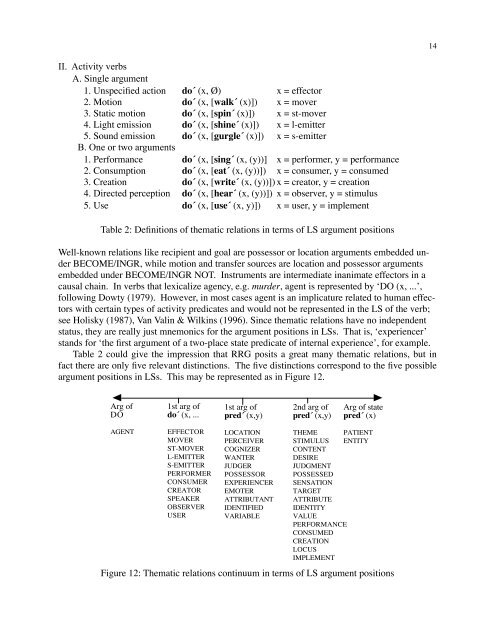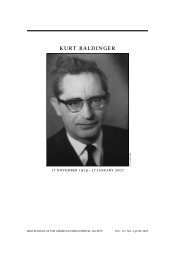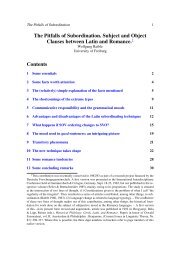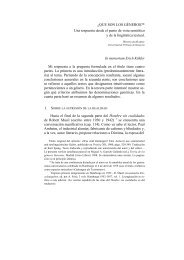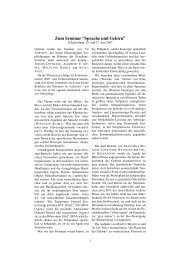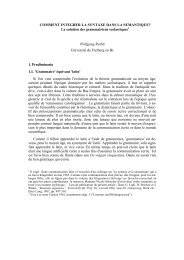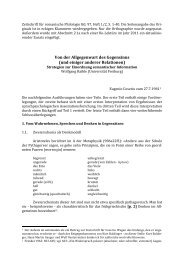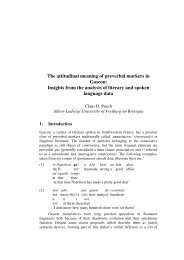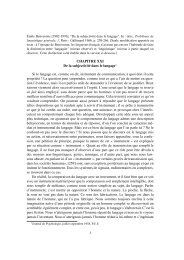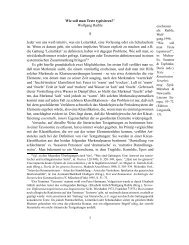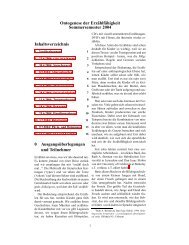A Summary of Role and Reference Grammar
A Summary of Role and Reference Grammar
A Summary of Role and Reference Grammar
You also want an ePaper? Increase the reach of your titles
YUMPU automatically turns print PDFs into web optimized ePapers that Google loves.
II. Activity verbs<br />
A. Single argument<br />
1. Unspecified action do´ (x, Ø) x = effector<br />
2. Motion do´ (x, [walk´ (x)]) x = mover<br />
3. Static motion do´ (x, [spin´ (x)]) x = st-mover<br />
4. Light emission do´ (x, [shine´ (x)]) x = l-emitter<br />
5. Sound emission do´ (x, [gurgle´ (x)]) x = s-emitter<br />
B. One or two arguments<br />
1. Performance do´ (x, [sing´ (x, (y))] x = performer, y = performance<br />
2. Consumption do´ (x, [eat´ (x, (y))]) x = consumer, y = consumed<br />
3. Creation do´ (x, [write´ (x, (y))]) x = creator, y = creation<br />
4. Directed perception do´ (x, [hear´ (x, (y))]) x = observer, y = stimulus<br />
5. Use do´ (x, [use´ (x, y)]) x = user, y = implement<br />
Table 2: Definitions <strong>of</strong> thematic relations in terms <strong>of</strong> LS argument positions<br />
Well-known relations like recipient <strong>and</strong> goal are possessor or location arguments embedded under<br />
BECOME/INGR, while motion <strong>and</strong> transfer sources are location <strong>and</strong> possessor arguments<br />
embedded under BECOME/INGR NOT. Instruments are intermediate inanimate effectors in a<br />
causal chain. In verbs that lexicalize agency, e.g. murder, agent is represented by ‘DO (x, ...’,<br />
following Dowty (1979). However, in most cases agent is an implicature related to human effectors<br />
with certain types <strong>of</strong> activity predicates <strong>and</strong> would not be represented in the LS <strong>of</strong> the verb;<br />
see Holisky (1987), Van Valin & Wilkins (1996). Since thematic relations have no independent<br />
status, they are really just mnemonics for the argument positions in LSs. That is, ‘experiencer’<br />
st<strong>and</strong>s for ‘the first argument <strong>of</strong> a two-place state predicate <strong>of</strong> internal experience’, for example.<br />
Table 2 could give the impression that RRG posits a great many thematic relations, but in<br />
fact there are only five relevant distinctions. The five distinctions correspond to the five possible<br />
argument positions in LSs. This may be represented as in Figure 12.<br />
Arg <strong>of</strong><br />
DO<br />
AGENT<br />
1st arg <strong>of</strong><br />
do´ (x, ...<br />
EFFECTOR<br />
MOVER<br />
ST-MOVER<br />
L-EMITTER<br />
S-EMITTER<br />
PERFORMER<br />
CONSUMER<br />
CREATOR<br />
SPEAKER<br />
OBSERVER<br />
USER<br />
1st arg <strong>of</strong><br />
pred´ (x,y)<br />
LOCATION<br />
PERCEIVER<br />
COGNIZER<br />
WANTER<br />
JUDGER<br />
POSSESSOR<br />
EXPERIENCER<br />
EMOTER<br />
ATTRIBUTANT<br />
IDENTIFIED<br />
VARIABLE<br />
2nd arg <strong>of</strong><br />
pred´ (x,y)<br />
Arg <strong>of</strong> state<br />
pred´ (x)<br />
THEME PATIENT<br />
STIMULUS ENTITY<br />
CONTENT<br />
DESIRE<br />
JUDGMENT<br />
POSSESSED<br />
SENSATION<br />
TARGET<br />
ATTRIBUTE<br />
IDENTITY<br />
VALUE<br />
PERFORMANCE<br />
CONSUMED<br />
CREATION<br />
LOCUS<br />
IMPLEMENT<br />
Figure 12: Thematic relations continuum in terms <strong>of</strong> LS argument positions<br />
14


